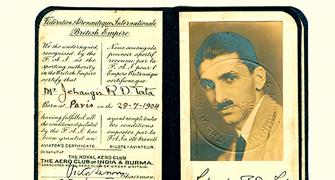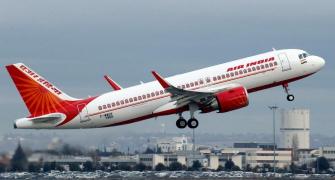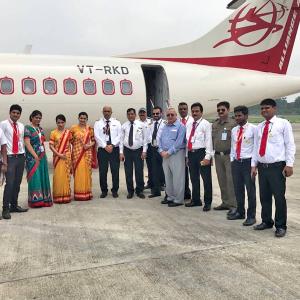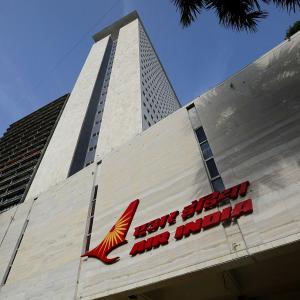There is no reason for keeping an entire ministry with a total staff strength of 2,300, just for the oversight of a few aviation sector laws and regulatory bodies, notes A K Bhattacharya.

The Narendra Modi government's decision to privatise Air India was an important milestone. The decision signified the launch of the Modi government's privatisation programme and marked the first outright sale of a state-owned enterprise in the last 18 years.
It was a difficult transaction, given the huge debt Air India had piled up over the years. No doubt the government got very little money from the sale and is now left with the debt that has been transferred to a newly created holding company. But the daily bleeding of the Centre's finances by about Rs 20 crore (Rs 200 million) should come to an end when in December the privatisation deal is concluded.
If Air India goes back to its original owner -- the Tatas -- the government too will be left with no airline to look after. Does it then not mean that the privatisation decision should be quickly followed up with some major restructuring of the civil aviation ministry that used to look after Air India?
Indeed, the gains from the sale of Air India would be incomplete if follow-up steps are not taken to reorganise the civil aviation ministry at the Centre. Reforms of this ministry are long overdue, and the Air India sale should expedite such a decision.
What does the Union civil aviation ministry do?
The ministry is responsible for formulating national policies and programmes for the development and regulation of the civil aviation sector in the country. It is also responsible for the administration of the Aircraft Act, Aircraft Rules and a few other laws pertaining to the aviation sector.
More importantly, the ministry exercises administrative control of organisations such as the Directorate General of Civil Aviation, the Bureau of Civil Aviation Security, the Airports Economic Regulatory Authority of India, the Commission of Railway Safety, the Aircraft Accident Investigation Bureau, the Airports Authority of India and Air India.
Now that Air India has been sold, the civil aviation ministry will certainly have some surplus capacity in terms of its manpower. A quick look at the work allocation among senior officers of the ministry shows that Air India takes up the bulk of the work of three senior officials -- a joint secretary, a director and an under-secretary. These officers can be easily redeployed in some other ministries, or the manpower size of the civil aviation ministry could be suitably curtailed.
Indeed, the justification for such re-sizing of the civil aviation ministry arises not just because of the sale of Air India. There is no reason for keeping an entire ministry with a total staff strength of 2,300, just for the oversight of a few aviation sector laws and regulatory bodies.
Ideally, the DGCA should be hived off as an independent regulatory organisation. The aviation regulator should not have been an extension of the ministry. Instead, let it be an independent and suitably empowered regulator, without being guided and influenced by the aviation ministry.
In any case, you don't need a joint secretary in the ministry, along with two other senior officers -- of the rank of a director and an under-secretary, to oversee the functioning of a regulator. Such a structure can play havoc with the autonomy of a regulator.
The ministry should lay down the policy and give the DGCA the freedom to implement the policy. If there is a need for an appellate body to address grievances of aviation players against decisions taken by the DGCA, such a body should be created, instead of the civil aviation ministry taking such calls on dispute settlement.
Similarly, the AERAI should not be treated by the civil aviation ministry as one of the organisations over which it must exercise its administrative control. With a massive plan to hand over the ownership and management of many airports to private enterprises, the AERAI must not be seen as an extension of the civil aviation ministry.
This is particularly important to dispel any impression of any private sector operator of an airport using its political connections to exercise influence over airport regulation in a way that could give it an unfair advantage over its rivals.
The functioning of organisations like the BCAS and the AAIB should also be made independent of the civil aviation ministry. The functions and role of these organisations are best performed if they do not operate as an extension of the ministry.
The intent of the legislation behind their creation, just as those for the DGCA and the AERAI, was to facilitate their functioning autonomously within the broad framework of the policy laid down by the government. But at present they function more like an outfit of the ministry.
There can be little debate over relocating the office of the CRS as an independent body. This office was created under the aviation ministry to give it the kind of autonomy and independence it must enjoy while investigating railway accidents and ensuring enforcement of safety norms.
That was why it was situated under the administrative control of the civil aviation ministry, many years ago in 1989 under the Railway Act.
It is time that the CRS was made a truly independent and sufficiently empowered organisation to examine railway safety issues and accidents. No purpose is served by keeping it under the civil aviation ministry.
This will leave only the overall supervision of the AAI, a State-owned enterprise, with the ministry of civil aviation. The obvious question that will arise is why the civil aviation ministry's size should not be shrunk significantly to reflect its substantially reduced role.
Downsizing the manpower in the aviation ministry would make it leaner and more efficient. More importantly, this will make the regulatory bodies in the civil aviation sector, like the DGCA, the AERAI, the BCAS and the AAIB, truly autonomous. The aviation ministry would also be restricted from influencing these organisations beyond playing its legitimate role in policy-making.
If this major ministerial reorganisation can be achieved in the civil aviation ministry, the same template could be enforced in other central ministries.
For instance, if banks are to be privatised, the role and relevance of the department of financial services should be revisited. If such reforms do indeed take place, the real gains of privatising Air India and banks can percolate to the governance structure of central ministries.
Soon after taking charge as prime minister in 1977, Morarji Desai had told an upright and efficient banking secretary: 'I want to abolish the banking department, but I will not abolish you."'Eventually, however, Desai could only convert the banking department into a division.
Almost 45 years later, another Gujarati prime minister has an opportunity of abolishing or truncating the size of a ministry or a department.
Like Desai, he may not entirely succeed in his mission. But even a partial step in that direction should yield rich dividends for the country's governance structure.










